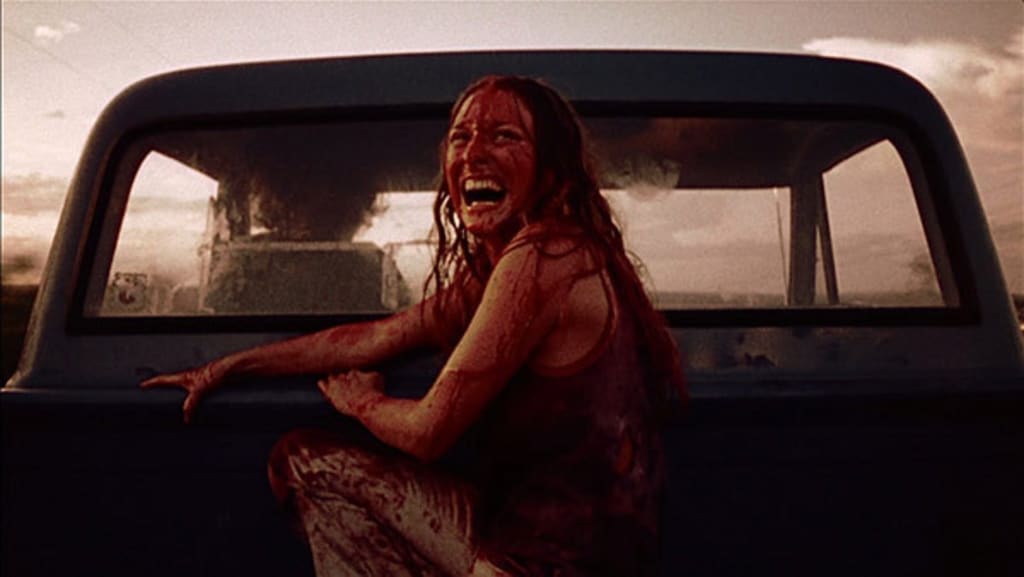Remembering Tobe Hooper Through His Masterpiece, The Texas Chainsaw Massacre
Tobe Hooper died but The Texas Chainsaw Massacre lives forever.

Director Tobe Hooper died today, he was 74 years old. Hooper’s very first film, The Texas Chainsaw Massacre became an iconic horror classic in 1974 without getting the credit it deserves as a film. People like my critical brethren to this day write off The Texas Chainsaw Massacre as just a slasher film intended to shock and appall. But there is so much more to The Texas Chainsaw Massacre than just hack n’slash. Whether he knew it or not, Tobe Hooper was directing the last movie of the Hippie Generation and capturing, in the most visceral and violent metaphor imaginable, the death of the ideals of an entire generation of people.
The Texas Chainsaw Massacre is a slasher movie; arguably the most influential slasher movie of all time. The style and story of The Texas Chainsaw Massacre has been stolen, recycled and regurgitated as much or more than some of the all-time great movies from Casablanca to The Godfather to Star Wars. But while those films hold laudable places within our collective pop consciousness, The Texas Chainsaw Massacre is belittled and degraded as something that is just ugly and disturbing.
The Texas Chainsaw Massacre tells the story of five young people traveling across Texas in a van in search of the family farm belonging to the parents of Sally (Marilyn Burns) and her wheelchair bound brother Franklin (Paul A. Partain). Along for the ride are Sally’s boyfriend Kirk (William Vail) and another couple, Jerry (Alan Danziger) and Pam (Teri McMinn).
Right off the bat, the hippie parallels are clear, the van, though not a classic VW Bus, is apropos of what has become a hippie cliche. The casual shagginess of the characters, the way the girls are dressed and all the talk of horoscopes and zodiac signs all hint at caricatures of the Love Generation. That caricature extends to the easy going attitude the group takes toward picking up a hitchhiker; charity, especially offered to a stranger and fellow traveler, is part of the hippie ethos.
The hitchhiker, unfortunately, is the first signal of the changing times and how the hippie values of trusting unconditionally your brother and fellow traveler backfires almost immediately in a reactionary swing of a chainsaw. When the hitchhiker repays their kindness with a terrifying display of self-mutilation and bullying intimidation, it’s the first indication that Tobe Hooper is delivering a harsh reality check to the generation that lived to pick up strays and smile on your brother. That time was ending and Texas Chainsaw Massacre was the cold hard light of day.
After ditching the hitchhiker our hippie travelers make their way to Sally’s family farm while running low on gas for the van. Seeking help, Jerry and Pam make their way to another nearby rural home and not finding anyone answering their knock, Jerry enters the home to seek assistance. In subsequent years, such an intrusion has become a horror movie cliche, but in Texas Chainsaw Massacre this moment is remarkably symbolic of the end of its era.
While I come from a generation who have been warned away from approaching strangers and lived in a home in a small town where the door would be locked at the end of the day, I am familiar only from my parents with a time when small town neighbors lived intimately to the point where walking into someone else’s home was a common and welcome occurrence. Strangers would be obliged to knock first but the door would not be locked and a welcome mat often meant just that.
1974, however, was a time when such values were shifting. Crime was encroaching upon the Midwest, out of big cities and into even the smallest of small towns. Television news spread the image of crime and potential dangers of an open society nationwide, especially in the form of Charlie Manson, a bitterly ironic image of a supposed hippie turned killer. Jerry’s intrusion into the home of Leatherface and his subsequent violent death are horrifically symbolic of this change in society.
In the character of Franklin, we find the specter of Vietnam; a war that loomed over and eventually doomed the hippie idyll. Frank is in a wheelchair, he’s bitter, he’s constantly fiddling with a knife. We don’t know how Frank ended up in this wheelchair and thus we can project upon him the frame of history. Vietnam was winding down in ’74 and an embattled, often embittered, generation of men, not unlike Franklin, came home missing pieces of themselves, in some cases left in wheelchairs. Again, Hooper never makes mention of Vietnam or how or why Frank is in a wheelchair but the assumption on our part is very easy and quite reasonable.
Vietnam galvanized the hippie movement, it brought this generation of peace and love together with the common goal of bringing an end to the bloody conflict. For a flickering moment, as Bobby Kennedy was racing to the White House, and even surviving his assassination to Woodstock, it seemed like peace and love could stop a war. Woodstock sadly was followed by the twin tragedies of the Rolling Stones’ free concert at Altamont and the devastating shooting at Kent State. By the time Richard Nixon was re-elected in 1972 and Watergate began to unfold tragedy and violence had the Hippie movement on its last legs.
When The Texas Chainsaw Massacre arrived in 1974, with its surrogate hippies crossing the country in their van spreading good cheer and picking up strays along the way to share the love, the fate of the five travelers became the true fate of the love generation, torn to shreds by repeated tragedies until all that was left was a painful memory of what might have been. Leatherface is the surrogate establishment eager to bash the idealism out of the love generation before carving what was left into nothing. The hippie generation symbolically dies on screen bathed in the blood of Vietnam, Bobby Kennedy, Altamont and Kent State.
Ah but you say, Sally Hardesty survived The Texas Chainsaw Massacre. Well if I may continue to project my view on to Mr. Hooper's movie, Sally’s survival is as symbolic as the many deaths in The Texas Chainsaw Massacre. The dream of the Hippies, the love generation, was a community of people who worked together for a common purpose of enriching everyone.
As one by one the community of Sally and her friends are murdered that belief in community melts away to a more self-focused search for survival, the perfect metaphoric pre-cursor to what in the late 70’s Saturday Night Live and others would call “The Me Generation.” The Me Generation rejected everything that the hippies believed in. The Me Generation was about stepping over your fellow man to further your own interests.
Fear and self-preservation meet then with a troubled economy under Jimmy Carter and by the time the ultimate anti-hippie, Ronald Reagan, takes office, the values of the love generation are but a punchline and a stereotype, and even its most ardent remaining proponents are morphing from hippies to yuppies, buying into the selfish ideal, and buying stock; forgetting the time they once wanted to live in a commune.
The dinner scene in The Texas Chainsaw Massacre aches even more with metaphor than much of the rest of the film. What is missing from this horrific family dinner? What familial element is lacking not only from the dinner table but indeed from the lives of Leatherface, his father, grandfather and brother? A mother is missing. Indeed, aside from what we can only assume is the decaying corpse of Leatherface’s grandmother upstairs, we have no indication of any feminine influence in the lives of these deeply troubled men.
In 1974, we have the burgeoning women’s movement, women were taking to the streets to campaign for equal rights and demanding their place in the workplace. The absence of a mother has left a gaping hole in the Leatherface family just as many women moving out of the home and into the workplace changed the landscape of the nuclear family forever, in many good ways and yes in ways that we have yet to truly come to terms with even 40 some years later.
The torturing of Sally Hardesty in this scene plays like an accusation, a cry from frightened men desperately seeking their mommy and acting out violently at her absence. The violence of this scene is not so much physical as it is emotional as we press in closer on Sally’s eyes. The lack of a motherly presence where there once was one, has brought us to a point of unchecked male aggression and Sally becomes the stand in, the placeholder for the anger men felt toward not having a woman waiting at home to care for them.
I am projecting a great deal onto one movie, one that may have had no pretension toward the kind of significance I am giving it. Nevertheless, when viewed from 43 years later, with time to consider the film’s place in both cultural history and chronological history, you must admit there is something to what I have written here.
With the perspective of history, it is fair to say that The Texas Chainsaw Massacre was the last hippie movie, the one that shut out the lights on the last, lingering ideals of the love generation and pointed the way toward a very a different and depressing set of ideals.
Few images stick in people’s minds the way that Leatherface spinning, screaming and swinging that chainsaw has endured for so long. That image is yet another remarkable metaphor of changing times. A man desperately unchained from reality, undoubtedly warped by tragedy, lashing out at the world as violently as possible because violence is the only medium in which he can communicate.
Leatherface is America in 1974, an angry, scared, confused and dangerous man facing uncertain future. The image is strangely childlike as he twirls about and with Nixon in the White House and Watergate about to topple a President, what could be more symbolic than a frightened, dangerous overgrown child and a most remarkable level of uncertainty in an uncaring world.
Even more meaningful is the final image in The Texas Chainsaw Massacre, of Sally Hardesty covered in blood and screaming as she desperately begs for escape. It is, for me, one of the most powerful and cathartic images in film history. The blood is full of symbolism, it’s the blood of John F. Kennedy, the blood of Robert Kennedy, Martin Luther King, Malcolm X, Vietnam, Altamont, Kent State and so many more tragedies that in the time of the Hippie Generation were definitive, altering lives and American history forever.
For one film to capture that metaphor so perfectly, seemingly without even intending to is one of the most remarkable achievements in cinema. For me, that is the legacy of Tobe Hooper and what an extraordinary legacy that truly is.
About the Creator
Sean Patrick
Hello, my name is Sean Patrick He/Him, and I am a film critic and podcast host for the I Hate Critics Movie Review Podcast I am a voting member of the Critics Choice Association, the group behind the annual Critics Choice Awards.






Comments
There are no comments for this story
Be the first to respond and start the conversation.